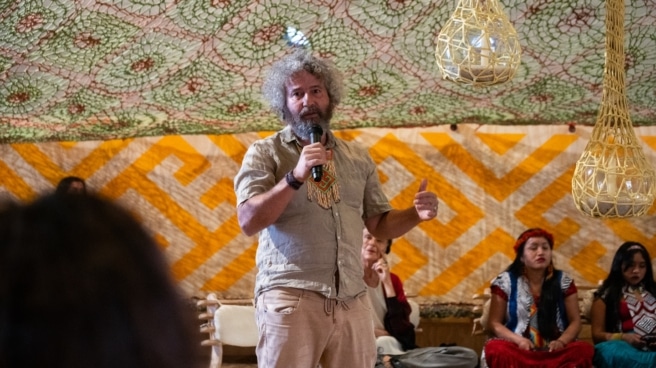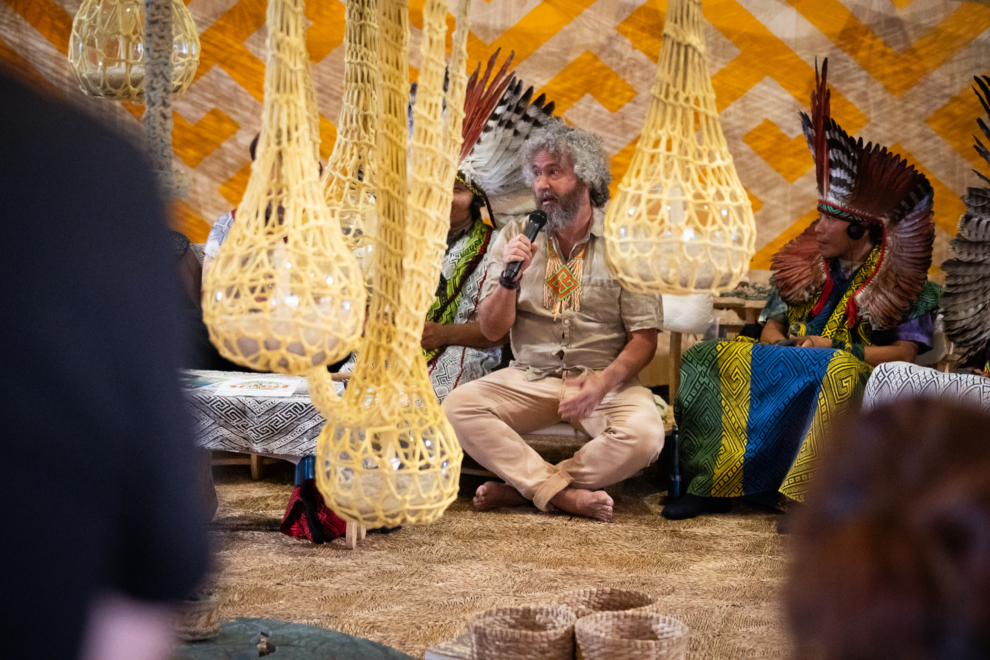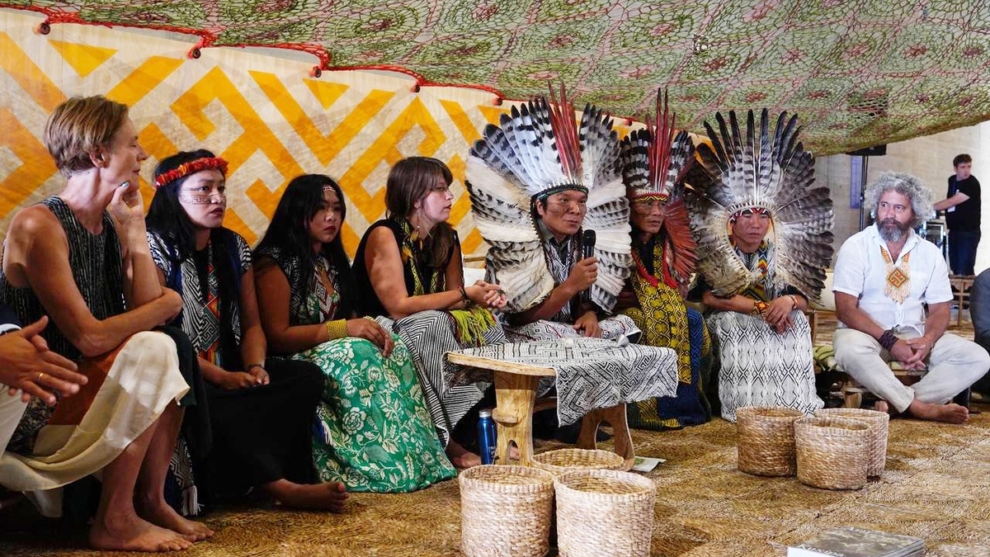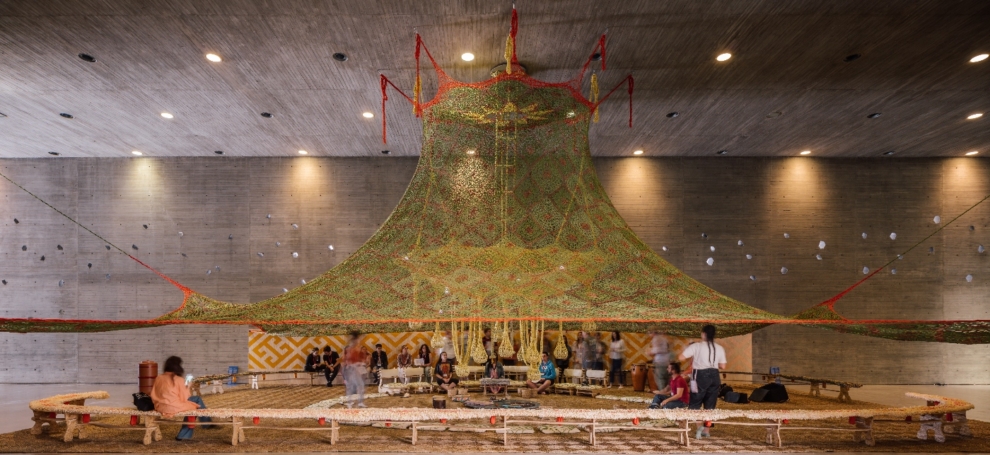

Brazilian artist Ernesto Neto at the presentation of his installation “BasnepuruTxanaYubé” (2015) at the exhibition “Remedios” at C3A in Cordoba.
Ernesto Neto (Rio de Janeiro, Brazil, 1964) is a very unique artist. At the heart of his speech is a revolutionary, a kind of wise shaman who comes to remind us of the need to return to our origins in nature to explore our humanity. On the other hand, the interest of the art world in his work makes him one of the most famous and sought-after artists of our time, whose turnover reaches 134 thousand euros, according to artprice.com. Through this explosive combination of social commitment and commercial success, the power of his message reaches a transcendental and cultural significance that is as colorful as it is provocative.
In Spain, his work can be seen in Barcelona (MACBA, Blueproject Foundation), Bilbao (Guggenheim), Madrid (Elba Benitez Gallery), and recently in Cordoba (C3A), where the Brazilian spoke with Independentafter the presentation of his BasnepuruTehanaYube (2015) as part of the exhibition Medicines: along the birth pathfrom the TBA21 Foundation.
Heir to the neo-concrete movement, his works are not just objects for aesthetic exhibition. Neto encourages interaction and sensory experience through installations, sculptures and drawings that invite viewers to participate and appreciate the spirituality and sensuality inherent in his creations.
Disheveled gray hair, tangled beard and piercing eyes. Ernesto Neto cannot sit still, moreover, he never sits down while talking. He speaks, gestures and expresses himself like a prophet, an enlightened artist who has seen the light through a genuine immersion in the culture of the Huni Kuin, an indigenous people of the Amazon with whom the artist has collaborated for over a decade.
“The world has changed a lot in recent years, before no one talked about indigenous peoples and cultures, there was no desire to exchange views with indigenous peoples, and today they are the main characters. There is a feeling that a lot has changed, and Huni Queen and “I myself think that this struggle was worth it. Because we are very aware that we have worked in a field of a lot of rejection, but today the panorama is much more open,” explains Neto.
The Brazilian artist recalls being criticized at the 2017 Venice Biennale for “taking advantage” of colleague Huni Quinn. “They said he treated them as if it were a circus. They do this because they don’t understand, because they are afraid. They talked about them as if they were different, when in fact they were different, because I’m Brazilian, I’m closer to Huni Queen than to white Europeans.”
Indigenous Advocate
Neto speaks of indigenous peoples with admiration and admiration, establishing himself and his art as a bridge between cultures. “The Huni Queen divide their history into 5 parts: first there was the time of malok when they lived peacefully in the jungle, then the time of contact when they met the western man, followed by the time of the raid when they began to run away from the western man. Then came the time of captivity, when the white man made them slaves to extract rubber, and they could not speak their language, sing their songs, perform their rituals, paint and practice their art, because everything was from the devil. Finally in the 70s years began the time of rights, when non-indigenous people were kicked out and returned to their lands. Now they live in a new time, the time of culture, with the principle that culture is protection “Culture is strength. This is the bridge work that began in Rio de- Janeiro reached Europe when they began to immerse me in the world of art, a very symbolic world of culture.”
The Rio-based artist states that his work seeks to find changes in nature, which is where this collaborative process came from. “I work with nature, with the body, based on the principle that the body is as important as the mind, and that one is part of the other. Through exploring this power of nature, I ended up meeting the indigenous peoples who are closest to nature.”

Protecting nature versus Western culture
The Brazilian does not hesitate to blame Western cultural hegemony for the beginning of humanity’s problems. “Christianity ceased to be the center of the world when it discovered that the Sun did not revolve around the Earth. When they lost their natural hegemony, they became the owners of culture as a fact that distinguished them from others and made them superior beings. God, as written in the Bible. “We are the image of God, and nature is here to serve us.” That’s the problem.”
Neto’s speech is particularly critical of the Christian religion. “We have been deceived for 2,000 years because the image of Jesus on the cross is not the image of Jesus, but the image of the murderers who killed Jesus. If Jesus did anything to save us, it was to live, not the Cross – it is an instrument of torture, designed to kill, it is sadness, misfortune, envy, rage, an atomic bomb, war. When Jesus is a song, it is a dance, it is joy, brotherhood, love, respect, attention, calm, peace. We live in the image of Jesus on the cross, so when we let go of that image and begin to walk, we enter a state of introspection, we connecting with heaven and earth, we walk more fully, we understand that Culture is important, but nature is far beyond all this.

The need for re-enchantment
In this sense, Neto justifies Huni Queen’s lifestyle and understanding of life. “The snake for them is a spiritual connection. If the sacred serpent had not given the apple to the woman to share with Adam, she and Adam would be in heaven today, it would be wonderful. But without the sacred serpent none of us could be here today, perhaps it was better, but what is certain is that we are, we are the children of the sacred serpent, the mother of humanity, and for Huni Queen this represents a complete connection with spiritual power, love land and famine on earth. The Huni Queen continue to live in an enchanted world, and the principle of magic is fundamental. Western culture is a culture of disappointment; the process of civilization has been a process of disappointment. This is something that is very well told in Caliban and the Witch, Silvia Federici. This process of disillusionment, the end of communal lands, the total organization of the body, how to be, how to walk, how to speak, the control of time, the total mechanization of the body and the oppression of women, who were great shamans who worked with plants that had contraceptive properties. The Church, on the contrary, uses earthly power, Holy Week takes place on the first full moon of spring in the northern hemisphere, a time of wonderful celebrations, the return of the revival of everything. These were fertility festivals, often with free sexuality. All this was suppressed by the cross. They use telluric power for repression. We are repressed every day by newspapers that follow the principle of the cross. What the Huni Queens want is for the time to re-enchant. “We have no chance of a fulfilling future unless we have a re-enchantment process.”
A Brazilian artist attacks a system in which eight billion people live as desperate miners searching for silver. “We are all desperate miners, working for meager wages, eight hours a day, having weekends that don’t allow us to rest because we have to work more. We are all in the same situation, there are also very wealthy people. , calm, getting fat, like me, for example, and other short and starving people who dig a mine all day long. Inequality is the great problem of humanity, we will end it only on the day when we join hands and sing together, regardless of gender, political positions and everything else.

The Role of Art in the Enchanting Process
And what role can art play in this whole process? For Neto, art is in everything, magic is art. “What happens between us and a work of art is magic. It is through art that we can achieve this, but art also needs to be enchanted because it is the prey of Western culture. So this local work is trying to break down this cultural wall, this Christian wall. Christianity is very powerful because it separates man and landscape. For many years my work has stated and attempted to achieve continuity between the body and the landscape, because the land is the body. I always thought of it as referring to the phrase Lygia Clarkmy spiritual and creative grandmother who made a piece called Home or body (Home – body) in the 70s, during the Brazilian military dictatorship. One day, after I smoked a joint, I had a vision in which the phrase was updated to read: “The earth is the body.” Because when we see the Earth as a body, we see ourselves inside it, part of it, like microbes that are part of us.”
“I don’t know if there is a cure, the situation is very serious, it is very difficult to reverse the cruelty of humanity, but I try to create positions of comfort, protection, where we can get in touch with ourselves, understand our bodily relationships. What the Greeks did, which the Renaissance later expanded upon, was to separate the mind from the body and the landscape. We turned the Earth into a landscape and saw it as separate from us, which is why we felt we had the right to take everything from it. This is a fundamental issue for me, achieving this continuity.”
Source: El Independiente